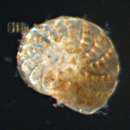en
names in breadcrumbs


Globothalamea is the name given by Pawlowski et al. (2013) to a monophyletic taxon, or subclade, within the more inclusive clade Foraminifera. The authors employ a rank-based system of nomenclature (e.g, Linnean nomenclature), assigning the taxonomic rank of Class to Globothalamea.
The diagnostic morphological characters of Globothalamea as given by Pawlowski et al. (2013: 8) are as follows: “Test multi-chambered, typically trochospirally enrolled, but may be triserial, biserial or uniserial; chambers globular or crescent-shaped in early stage; wall agglutinated or calcareous.” The molecular synapomorphies for the clade Globothalamea given by Pawlowski et al. (2013: 8) are: an average SSU rRNA gene length of 3500 nt (3000-4000 nt), a GC content of 40%) GC content; and a conserved motif in the variable region 41f of the small subunit ribosomal DNA (Pawlowski and Lecroq 2010).
The taxonomic composition of Globothalamea as defined by Pawlowski et al. (2013: 8) is: Textulariida (Reophax sp., Leptohalysis scotti, Eggerella sp., Trochammina sp., Eggerelloides scaber, Trochammina hadai, Spirotextularia sp., Textularia sagittula), Carterinida (no taxa included in analysis or on reference tree), Robertinida (Robertina arctica), and Rotaliida (Cibicides lobatulus, Hyalinea baltica, Oridorsalis umbonatus, Pullenia subcarinata, Pararotalia nipponica, Heterostegina depressa, Nummulites venosus, Bulimina marginata, Melonis pompilioides, Epistominella exigua, Stainforthia fusiformis, Trifarina earlandi, Uvigerina phlegeri, Cassidulinoides parkerianus, Islandiella norcrossi, Globorotalia inflata, Neogloboquadrina dutertrei).
The geologic range given for Globothalamea is Lower Cambrian to Recent.
In reference to the phylogeny of Foraminifera depicted in Figure 1 (Pawlowski et al. 2013: 4), Globbothalamea is more closely related to an unnamed clade (Clade A + Clade C) comprised of an unnamed allogromiid (GenBank accession HE998678), and the xenophyophores Syringammina corbicula, Shinkaiya lindsayi, and Rhizammina algaeformis, than to Tubothalamea or any of the basal monothalamiid lineages.
As depicted on the reference phylogeny of Foraminifera (Pawlowski et al. 2013: Fig. 1), in which the node is labeled with drawing of a bilocular test, the name Globothalamea refers to a node-based crown clade, a clade whose name could also be defined using a node-based phylogenetic definition. See Article 2.2 in the PhyloCode Cantino and de Queiroz (2010) for an explanation of node-based names. Examples of node-based definitions for Globthalamea are: “the least inclusive clade containing Neogloboquadrina dutertrei (d’Orbigny, 1839) and Reophax sp. (GenBank accession: HE998675),” or “the clade originating with the most recent common ancestor of Neogloboquadrina dutertrei (d’Orbigny, 1839) and Reophax sp. (GenBank accession: HE998675).”
Globothalamea[1] comprises a class of multichambered foraminifera based in part on SSU rDNA evidence;[2] the other is Tubothalamea.
Six orders are included, which vary notably in composition, wall structure, and chamber arrangement. The Lituolida, Loftusiida, and Textulariida (as emended) have tests (shells) of agglutinated matter, glued together by various cements, but differ in chamber arrangement, wall structure, and complexity. In contrast the Carterinida, Robertinida and Rotaliida, with buliminids lumped into the Rotaliida, have calcareous tests. Those of rotaliid genera, which vary considerably, are of perforate hyaline (glassy) calcite. in contrast the Carterinida have tests composed of bundled calcite spicules. The Robertida differ in being composed, instead, of aragonite.[3]
Subclass Textulariia
Unassigned
Globothalamea comprises a class of multichambered foraminifera based in part on SSU rDNA evidence; the other is Tubothalamea.
Six orders are included, which vary notably in composition, wall structure, and chamber arrangement. The Lituolida, Loftusiida, and Textulariida (as emended) have tests (shells) of agglutinated matter, glued together by various cements, but differ in chamber arrangement, wall structure, and complexity. In contrast the Carterinida, Robertinida and Rotaliida, with buliminids lumped into the Rotaliida, have calcareous tests. Those of rotaliid genera, which vary considerably, are of perforate hyaline (glassy) calcite. in contrast the Carterinida have tests composed of bundled calcite spicules. The Robertida differ in being composed, instead, of aragonite.
Subclass Textulariia
Orders: Lituolida – Loftusiida – TextulariidaUnassigned
Orders: Carterinida – Robertinida – Rotaliida